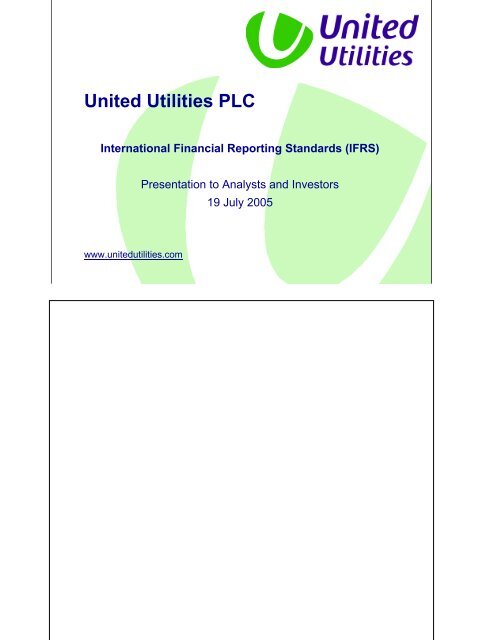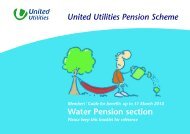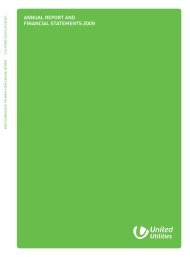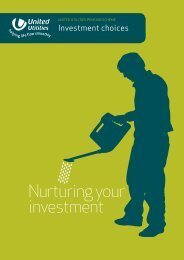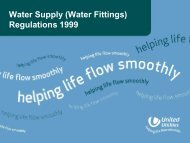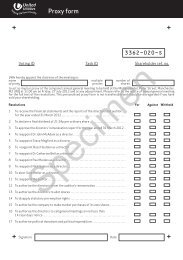IFRS presentation to analysts and investors - About United Utilities
IFRS presentation to analysts and investors - About United Utilities
IFRS presentation to analysts and investors - About United Utilities
Create successful ePaper yourself
Turn your PDF publications into a flip-book with our unique Google optimized e-Paper software.
<strong>United</strong> <strong>Utilities</strong> PLCInternational Financial Reporting St<strong>and</strong>ards (<strong>IFRS</strong>)Presentation <strong>to</strong> Analysts <strong>and</strong> Inves<strong>to</strong>rs19 July 2005www.unitedutilities.com
Cautionary statementInternational Financial Reporting St<strong>and</strong>ards (‘<strong>IFRS</strong>’) are being applied in theEuropean Union for the first time. New st<strong>and</strong>ards <strong>and</strong> interpretations may beissued by IASB <strong>and</strong> / or endorsed by the EU prior <strong>to</strong> the completion of our first fullreporting period under <strong>IFRS</strong> on 31 March 2006. There are a number of new <strong>and</strong>revised St<strong>and</strong>ards included within the body of St<strong>and</strong>ards that comprise<strong>IFRS</strong>. There is not yet a significant body of established practice upon which <strong>to</strong>draw in forming opinions regarding their interpretation <strong>and</strong> application. Accordingly,practice is continuing <strong>to</strong> evolve. At this stage, therefore, the full financial effect ofreporting under <strong>IFRS</strong>, as it will be applied <strong>and</strong> reported on in the Group’s first <strong>IFRS</strong>financial statements, cannot be determined with certainty <strong>and</strong> may be subject <strong>to</strong>change. The financial information which follows represents our current view <strong>and</strong>may be impacted by changes in the business or <strong>to</strong> <strong>IFRS</strong> or the interpretationthereof. This <strong>presentation</strong> should be treated with appropriate caution <strong>and</strong> shouldnot be relied upon.
Simon BateyGroup Finance Direc<strong>to</strong>rGood morning ladies <strong>and</strong> gentlemen, <strong>and</strong> welcome <strong>to</strong> our <strong>presentation</strong> on theimpacts of International Financial Reporting St<strong>and</strong>ards. With me on the platformis Martin Beesley, Finance Direc<strong>to</strong>r of our <strong>United</strong> <strong>Utilities</strong> North West business,the business which contributes the bulk of the <strong>IFRS</strong> impacts.Before we start, could you I remind you <strong>to</strong> please turn off any portable devicessuch as mobile phones <strong>and</strong> blackberrys. Thank you.
Agenda• Headlines• Background <strong>to</strong> <strong>IFRS</strong>Simon Batey,Group FinanceDirec<strong>to</strong>r• <strong>United</strong> <strong>Utilities</strong>’ basis of preparation• Major <strong>IFRS</strong> adjustments• Impact assessment• Earnings• Distributable reserves• Key ratios <strong>and</strong> financials• Commercial impact• SummaryMartin Beesley,Finance Direc<strong>to</strong>r<strong>United</strong> <strong>Utilities</strong>North WestSimon Batey,Group FinanceDirec<strong>to</strong>r• Q&A4In a moment I’ll take you through the headlines <strong>and</strong> provide a brief background<strong>to</strong> <strong>IFRS</strong> <strong>and</strong> the timetable implications for <strong>United</strong> <strong>Utilities</strong>.Martin will then talk about our basis of preparation, the major <strong>IFRS</strong> adjustmentsthat represent significant differences from UK GAAP, <strong>and</strong> their impact on ouraccounts.After Martin has finished, I’ll then focus on the effects on earnings, distributablereserves <strong>and</strong> key financials, <strong>and</strong> I’ll outline the commercial position <strong>and</strong> round upwith a summary of the key points.At the end we’ll be pleased <strong>to</strong> answer your questions.
<strong>IFRS</strong> conversion timetable31/03/04 31/03/05 31/03/0630/09/04 30/09/0530/09/06UK GAAPFirst <strong>IFRS</strong>ResultsH1 05/06Publish FirstAnnual Report<strong>and</strong> Accounts<strong>IFRS</strong> Restatement<strong>IFRS</strong> ReportingTransitionalDate for <strong>IFRS</strong>Adoption Date ofIAS 32 <strong>and</strong> IAS 39under transitionalrules5This chart outlines the timeline for <strong>IFRS</strong> conversion.The application of <strong>IFRS</strong> for listed companies commences for accounting periodsstarting on or after 1 January 2005. For <strong>United</strong> <strong>Utilities</strong>, this applies from 1 April2005.Although the st<strong>and</strong>ards are being adopted by <strong>United</strong> <strong>Utilities</strong> from the 2005/06financial year, <strong>IFRS</strong> continues <strong>to</strong> develop <strong>and</strong> there may be further accountingadjustments in the future.<strong>United</strong> <strong>Utilities</strong> has chosen <strong>to</strong> apply IAS 32, Financial Instruments: Disclosure<strong>and</strong> Presentation, <strong>and</strong> IAS 39, Financial Instruments: Recognition <strong>and</strong>Measurement, from 1 April 2005.The company’s first set of results under <strong>IFRS</strong> will be the six month period <strong>to</strong> 30September 2005 <strong>and</strong> will be communicated <strong>to</strong> the City, as usual, at an interimresults <strong>presentation</strong> in the autumn.Our first annual report <strong>and</strong> accounts under <strong>IFRS</strong>, relating <strong>to</strong> the 2005/06 financialyear, will be published in the summer of 2006.
Summary• Overall impact on profit before tax in 2004/05 is not material• Whilst earnings are affected by an increase in reported deferred tax, there isno impact on the group’s cash flow position or financing arrangements• A potential increase in volatility <strong>to</strong> the income statement is anticipated,primarily due <strong>to</strong> derivatives recognised at fair value• Net assets fall from £3,119m <strong>to</strong> £2,144m, primarily due <strong>to</strong> deferred tax <strong>and</strong>pensions adjustments• No effect on regula<strong>to</strong>ry asset base or allowed returns• No impact on payment of dividends <strong>to</strong> shareholders– <strong>United</strong> <strong>Utilities</strong> PLC parent company retained earnings largely unaffected– dividend policy unaffected6The overall impact of <strong>IFRS</strong> on 2004/05 profit before tax is not material.Earnings are largely unaffected on a pre-deferred tax basis.Whilst earnings will be affected by the requirement <strong>to</strong> provide in full for deferredtax, this is a non-cash adjustment which means that there will be no impact onthe group’s cash flow position or financing arrangements.We expect an increase in volatility <strong>to</strong> the income statement, primarily due <strong>to</strong>derivatives being recognised at fair value.Net assets fall from £3.1 billion <strong>to</strong> £2.1 billion, primarily due <strong>to</strong> deferred tax <strong>and</strong>pensions adjustments, which we’ll cover later in the <strong>presentation</strong>.However, there will be no effect on our regula<strong>to</strong>ry asset base or allowed returns<strong>and</strong> no impact on payment of dividends <strong>to</strong> our shareholders. The <strong>United</strong> <strong>Utilities</strong>PLC parent company retained earnings, from which we pay dividends, arelargely unaffected.Our dividend policy remains unchanged, that is, a target of increasing dividendsin line with inflation for the next five years.
<strong>IFRS</strong> headlines – effect on 2004/05 income800£m (2004/05)7006005004003002001000Operating Profit* Profit before Tax* Profit after TaxPrimarily due <strong>to</strong> anincrease in the deferredtax charge, which is anon-cash itemUK GAAP<strong>IFRS</strong>* before deferred tax <strong>and</strong> goodwill <strong>and</strong> exceptional items (UK GAAP) <strong>and</strong>,before deferred tax <strong>and</strong> intangibles previously classified as goodwill under UK GAAP <strong>and</strong> restructuring costs (<strong>IFRS</strong>)7This chart underlines the minimal effect on operating profit <strong>and</strong> profit before tax.The effect on profit after tax relates <strong>to</strong> deferred tax, which is a non-cash item.
<strong>IFRS</strong> headlines – summary impactFull Year 2004/05<strong>IFRS</strong>UK GAAPMovementOperating profit£676m 1£692m 2(2%)Profit before tax£395m 1£408m 2(3%)Adjusted Basic EPS59.5p 361.4p 4(3%)Basic EPS36.5p46.8p(22%)As at 31 March 2005Net assets£2,144m£3,119m(31%)Net debt£4,279m£4,141m3%<strong>United</strong> <strong>Utilities</strong> PLC ParentCompany DistributableReserves£1,182m£1,194m(1%)1before intangibles previously classified as goodwill under UK GAAP <strong>and</strong> restructuring costs2 before goodwill <strong>and</strong> exceptional items3 before deferred tax <strong>and</strong> intangibles previously classified as goodwill under UK GAAP <strong>and</strong> restructuring costs4before deferred tax <strong>and</strong> goodwill <strong>and</strong> exceptional items8This slide shows the effect of <strong>IFRS</strong> on some of our key financial measures.The impact on operating profit <strong>and</strong> profit before tax is just 2 per cent <strong>and</strong> 3 percent, respectively.Earnings per share, on a pre-deferred tax basis, moves by around 3 per cent. Themovement in basic earnings per share is primarily attributable <strong>to</strong> the non-cashdeferred tax adjustment.Our net assets are affected by the requirement <strong>to</strong> make full provision for deferredtax, under IAS 12, <strong>and</strong> the recognition of pension scheme deficits under IAS 19.Net debt increases by £138 million due <strong>to</strong> the proportional consolidation of jointventure debt, which is typically non-recourse <strong>to</strong> the group. However, thedistributable reserves of <strong>United</strong> <strong>Utilities</strong> PLC parent company, from whichdividend payments are made, are largely unaffected.Martin will say more about the impacts of IAS 12 <strong>and</strong> IAS 19 later in the<strong>presentation</strong>.
Segmental operating profit£m<strong>IFRS</strong> 1UK GAAP 2MovementYear ended 31 March 2005Licensed multi-utility operations562588(26)Infrastructure management907911Business process outsourcing2426(2)Telecommunications(5)(5)0Other activities880Corporate costs(3)(4)1Total operating profit676692(16)1 before intangibles previously classified as goodwill under UK GAAP <strong>and</strong> restructuring costs2 before goodwill <strong>and</strong> exceptional items9Before h<strong>and</strong>ing over <strong>to</strong> Martin, I would like <strong>to</strong> briefly outline the effect of <strong>IFRS</strong>on our segmentals. This table shows the adjustments <strong>to</strong> operating profit bybusiness. The main adjustments relate <strong>to</strong> our licensed multi-utility operationsbusiness, where operating profit decreases by around £26 million, principally due<strong>to</strong> the treatment of infrastructure assets, <strong>and</strong> our infrastructure managementbusiness, which sees an increase of around £11 million principally due <strong>to</strong> thetreatment of profits on disposals, previously treated as exceptional. Smalleradjustments <strong>to</strong> our business process outsourcing business <strong>and</strong> <strong>to</strong> corporate costsresult in a net decrease in <strong>to</strong>tal operating profit of £16 million under <strong>IFRS</strong>. As Isaid on the previous slide, this £16 million reduction represents just 2 per cent ofthe group’s <strong>to</strong>tal operating profit.Now I’ll h<strong>and</strong> over <strong>to</strong> Martin who will take you through the adjustments that weare making.
Martin BeesleyFinance Direc<strong>to</strong>r, <strong>United</strong> <strong>Utilities</strong> North WestThank you Simon, <strong>and</strong> good morning ladies <strong>and</strong> gentlemen.
<strong>United</strong> <strong>Utilities</strong>’ basis of preparation• Under <strong>IFRS</strong> transitional rules, <strong>United</strong> <strong>Utilities</strong> has made the followingprincipal choices:– <strong>to</strong> apply IAS 32 (Financial Instruments: Disclosure <strong>and</strong> Presentation)<strong>and</strong> IAS 39 (Financial Instruments: Recognition <strong>and</strong> Measurement),from 1 April 2005;– <strong>to</strong> use the fair value at the date of transition <strong>to</strong> establish a deemed costfor the opening balance sheet value of the infrastructure fixed assets;<strong>and</strong>– <strong>to</strong> recognise in full all actuarial gains <strong>and</strong> losses relating <strong>to</strong> pensionschemes both at the opening balance sheet date <strong>and</strong> prospectivelythrough the Statement of Recognised Income <strong>and</strong> Expense11Before I deal with the detail, let me talk a little bit about the choices we havemade. As Simon has already said, we’ve opted <strong>to</strong> apply IAS 32 <strong>and</strong> IAS 39 from1 April 2005, making use of the <strong>IFRS</strong> transitional rules. Consequently, there areno restatements relating <strong>to</strong> derivatives for 2004/05 accounts.As a result of changes in accounting for infrastructure assets, we’ve chosen <strong>to</strong> usethe fair value, at the date of transition, <strong>to</strong> establish a deemed cost for the openingbalance sheet value of the infrastructure fixed assets.The other principal choice we’ve made is <strong>to</strong> recognise, in full, all actuarial gains<strong>and</strong> losses relating <strong>to</strong> our pension schemes, both at the opening balance sheetdate <strong>and</strong> prospectively through the Statement of Recognised Income <strong>and</strong>Expense.
Major <strong>IFRS</strong> adjustments representing materialdifferences from UK GAAP• Infrastructure Accounting (IAS 16)• Interests in Joint Ventures (IAS 31)• Defined Benefit Pension Scheme Accounting (IAS 19)• Business Combinations (IAS 38 / <strong>IFRS</strong> 3)• Deferred Tax (IAS 12)• Dividends (IAS 10)• Accounting for Derivatives (IAS 39)12This slide outlines the major <strong>IFRS</strong> adjustments that represent a significantdifference from UK GAAP.What I’d now like <strong>to</strong> do is talk about each of these adjustments in turn <strong>and</strong>explain their impact on operating profit <strong>and</strong> net assets.
Infrastructure Accounting (IAS 16)• Accounting policies applied under UK GAAP in respect of all fixed assets,aside from water <strong>and</strong> wastewater infrastructure assets, are compliant with<strong>IFRS</strong> <strong>and</strong> remain the most representative mechanism by which <strong>to</strong> recordthose assetsOptions Available• In respect of the water <strong>and</strong> wastewater networks, 14 separate segmentshave been identified <strong>and</strong> useful lives assigned <strong>to</strong> each, ranging from 15 <strong>to</strong>300 years• IAS 16 requires that depreciation charged over an asset’s useful life isbased on the difference between cost <strong>and</strong> residual value• In the case of the water <strong>and</strong> wastewater network segments, the residualvalues are assumed <strong>to</strong> be insignificant13Before explaining the options available under IAS 16 <strong>and</strong> our basis ofpreparation, I’d like <strong>to</strong> highlight that in terms of impact, the accounting policiesapplied under UK GAAP in respect of all fixed assets, with the exception ofwater <strong>and</strong> wastewater infrastructure assets, are compliant with <strong>IFRS</strong> <strong>and</strong> remainthe most representative mechanism by which <strong>to</strong> record those assets.Various options are available when applying accounting for the water <strong>and</strong>wastewater infrastructure networks, since the st<strong>and</strong>ard is not prescriptive incertain areas.No concept of size is indicated by the st<strong>and</strong>ard when identifying the size <strong>and</strong>number of segments that should be individually recorded <strong>and</strong> depreciated withina single asset.We have therefore taken the view that an appropriate number has been reachedwhen it is not possible <strong>to</strong> significantly change the depreciation charge byrecognising a greater number of segments.This approach has led <strong>to</strong> our identifying fourteen separate segments, within thewater <strong>and</strong> wastewater networks, based on the classification of the components.Examples include water mains, sewers <strong>and</strong> tunnels. These have been allocateduseful lives ranging from 15 – 300 years.The <strong>to</strong>tal depreciation that is charged over an asset’s useful life is the differencebetween the asset’s cost <strong>and</strong> residual value. In the case of the water <strong>and</strong>wastewater networks it has been assumed that the residual values areinsignificant <strong>and</strong> that, at the end of a segment’s useful life, it will not have amaterial value.
Infrastructure Accounting (IAS 16)Basis of Preparation• Under FRS 15:– each infrastructure network is assumed <strong>to</strong> be one asset– depreciation charged is based on the estimated annual expenditurerequired <strong>to</strong> maintain the operating capacity of the network– actual expenditure is then capitalised as incurred• Infrastructure renewals accounting is not permitted under IAS 16– each infrastructure network has been divided in<strong>to</strong> a number ofsegments <strong>and</strong>, for each, a useful life has been determined so as <strong>to</strong>depreciate the segments individually14It may be worth reminding you of how infrastructure accounting is treated underFRS15. This will help <strong>to</strong> highlight the differences between UK GAAP <strong>and</strong> <strong>IFRS</strong><strong>and</strong> explain our basis of preparation.Under FRS 15, each infrastructure network is assumed <strong>to</strong> be one asset.Depreciation charged is based on the estimated annual expenditure required <strong>to</strong>maintain the operating capacity of the network. Actual expenditure is thencapitalised as incurred.Under IAS 16, infrastructure renewals accounting is not permitted. As discussedon the previous slide, it has therefore been necessary <strong>to</strong> divide each infrastructurenetwork in<strong>to</strong> a number of segments. For each segment a useful life has beendetermined, so as <strong>to</strong> allow each segment <strong>to</strong> be depreciated individually.
Infrastructure Accounting (IAS 16)Impact• No change <strong>to</strong> treatment of enhancement <strong>and</strong> maintenance expenditure– increases in capacity or enhancements of the network are treated asadditions– amounts incurred in maintaining the operating capability of the networkare expensed in the year• Opening balance sheet value of infrastructure renewals is established byreference <strong>to</strong> the fair value at the date of transition (as per <strong>IFRS</strong> 1)– results in £27m additional depreciation charge being introduced <strong>to</strong> the2004/05 results, impacting on profit before tax– fair value of network has increased by £145m (net of deferred tax),representing an upward adjustment <strong>to</strong> net assets of over 4%• this results in a net increase <strong>to</strong> shareholders’ funds15There has been no change <strong>to</strong> the treatment of enhancement or maintenanceexpenditure. Increases in capacity or enhancements of the network are treated asadditions, whereas amounts incurred in maintaining the operating capability ofthe network are expensed in the year.However, because the individual network segments identified have been assumed<strong>to</strong> have zero residual values at the end of their useful lives, this results in anadditional depreciation charge of around £27 million when compared <strong>to</strong> UKGAAP. This, therefore, impacts on operating profit <strong>and</strong> profit before tax.Net assets increase by around £145 million, net of deferred tax. This is due <strong>to</strong>electing <strong>to</strong> measure the net book values of the water <strong>and</strong> wastewaterinfrastructure networks at fair value <strong>and</strong> <strong>to</strong> use those fair values as their deemedcost.This results in a net increase <strong>to</strong> shareholders’ funds.There is no impact of <strong>IFRS</strong> on electricity infrastructure assets.
<strong>IFRS</strong> impact – 2004/05 operating profit*Operating Profit (£m)700650600550500450£646m(£27m)400UK GAAPInfrastructure Assets* after exceptional items <strong>and</strong> intangibles previously classified as goodwill under UK GAAP <strong>and</strong> restructuring costs16This chart shows the adjustment <strong>to</strong> operating profit as a result of IAS 16.
<strong>IFRS</strong> impact – net assets at 31 March 200535003000£3,119m£145mNet Assets (£m)25002000150010005000UK GAAPInfrastructure Assets17As you can see, net assets increase by around £145 million, net of deferred tax.
Major <strong>IFRS</strong> adjustments representing materialdifferences from UK GAAP• Infrastructure Accounting (IAS 16)• Interests in Joint Ventures (IAS 31)• Defined Benefit Pension Scheme Accounting (IAS 19)• Business Combinations (IAS 38 / <strong>IFRS</strong> 3)• Deferred Tax (IAS 12)• Dividends (IAS 10)• Accounting for Derivatives (IAS 39)18Now, moving on <strong>to</strong> IAS 31 <strong>and</strong> interests in joint ventures.
Interests in Joint Ventures (IAS 31)• Under IAS 31 we have the option of adopting equity accounting orproportional consolidation• <strong>United</strong> <strong>Utilities</strong> has elected <strong>to</strong> apply proportional consolidation– this is more representative of the group’s activities– joint venture interest <strong>and</strong> tax is reflected on the appropriate lines inthe income statement• No impact on operating profit, profit before tax or net assets• Typically, joint venture net debt is non-recourse <strong>to</strong> <strong>United</strong> <strong>Utilities</strong>• Overall, net debt increases by £138m as a result of IAS 31– no change <strong>to</strong> the financial resources of the business19Under IAS 31, we have the option of adopting equity accounting or proportionalconsolidation.The group has elected <strong>to</strong> apply proportional consolidation, as it is morerepresentative of the group’s activities than equity accounting. The joint ventureinterest <strong>and</strong> tax is reflected on the appropriate lines in the income statement,rather than being subsumed within operating profit.Overall, there is no impact on operating profit, profit before tax or net assets.However, there are a number of reclassification adjustments that net off, which Iwill address in the next two slides.Before moving on <strong>to</strong> that, it is worth pointing out that, although net debtincreases by around £138 million as a result of IAS 31, joint venture debt istypically non-recourse <strong>to</strong> <strong>United</strong> <strong>Utilities</strong>.There is no change <strong>to</strong> the financial resources of the business.
Interests in Joint Ventures (IAS 31)adjustments <strong>to</strong> income• Proportional consolidation adjusts certain items in the income statement,but the net effect is no impact on profit£mUK GAAPAdjustments<strong>IFRS</strong>Revenue: group <strong>and</strong> share of joint ventures114.3(30.8)83.5Less: share of joint ventures(114.3)114.3-Revenue-83.583.5Other income-1.21.2Purchases <strong>and</strong> production costs-(51.3)(51.3)General administration-(10.7)(10.7)Total operating costs-(60.8)(60.8)Operating profit-22.722.7Share of joint venture operating profit22.7(22.7)-Total operating profit22.70.022.720Looking at income statement adjustments, IAS 31 results in the inclusion of jointventure revenue within the group’s revenue. Previously under UK GAAP, groupturnover excluded the group’s share of joint venture turnover. Therefore,revenue increases by £84 million under <strong>IFRS</strong>.The revenue increase is partially offset by an increase in operating costs of £61million, thereby increasing reported group operating profit by £23 million.This is then netted off via a negative entry of £23 million, relating <strong>to</strong> the share ofjoint venture operating profit, resulting in no overall change <strong>to</strong> <strong>to</strong>tal operatingprofit.This reflects the investments in joint ventures line under UK GAAP beingsubstituted by the specific balance sheet components under <strong>IFRS</strong>.
Interests in Joint Ventures (IAS 31)adjustments <strong>to</strong> assets• Proportional consolidation increases non-current assets by £147m <strong>and</strong>current assets by £75m, offset by an adjustment of £39m <strong>to</strong> currentliabilities <strong>and</strong> £183m <strong>to</strong> long-term liabilities£mAdjustments£mAdjustmentsIntangible assets11.3Current tax payable1.4Property, plant <strong>and</strong> equipment206.0Trade <strong>and</strong> other payables37.3Other investments(70.5)Total current liabilities38.7Total non-current assets146.8Financial liabilities178.9Inven<strong>to</strong>ries2.6Other payables2.6Trade <strong>and</strong> other receivables31.8Provisions1.1Other investments(1.3)Total non-current liabilities182.6Cash <strong>and</strong> cash equivalents41.4Total current assets74.5TOTAL ASSETS221.3TOTAL LIABILITIES221.321Turning <strong>to</strong> the balance sheet, there are a number of significant reclassificationadjustments.Notably, tangible fixed assets increase by £206 million, offset by a reduction inintangible fixed assets <strong>and</strong> other investments of £59 million, resulting in anincrease <strong>to</strong> non-current assets of £147 million. Current assets increase by £75million, providing for an overall increase in <strong>to</strong>tal assets of £221 million.This is offset by an increase of £183 million in non-current liabilities <strong>and</strong> £39million in current liabilities, of which £138 million relates <strong>to</strong> debt.
Major <strong>IFRS</strong> adjustments representing materialdifferences from UK GAAP• Infrastructure Accounting (IAS 16)• Interests in Joint Ventures (IAS 31)• Defined Benefit Pension Scheme Accounting (IAS 19)• Business Combinations (IAS 38 / <strong>IFRS</strong> 3)• Deferred Tax (IAS 12)• Dividends (IAS 10)• Accounting for Derivatives (IAS 39)22Now, focusing on pensions.
Defined Benefit Pension Scheme Accounting (IAS 19)• Pension scheme surplus or deficit must be recognised as an asset or liabilityon the balance sheet– increases profit before tax by £4m, of which £3m relates <strong>to</strong> a reduction ininterest <strong>and</strong> £1m <strong>to</strong> an increase in operating profit– reduces net assets (net of tax) by £332m– comprises:• SSAP 24 prepayment reversal of £272.4m, which reflects the £320m(pre-tax) pensions pre-funding payment made on 31 March 2005; <strong>and</strong>• recognition of a deficit of £59.2m under IAS 19• Regula<strong>to</strong>ry determinations make explicit allowance for funding of the relevantelements of the pension scheme deficits23The group prepared its 2005 UK GAAP results in accordance with SSAP 24, with FRS17 transitional disclosures applied within the notes <strong>to</strong> the accounts. FRS 17 became fullyeffective for accounting periods beginning on or after 1 January 2005. The group has notadopted FRS 17 <strong>and</strong> will move directly <strong>to</strong> IAS 19.Under SSAP 24, any pension scheme surplus or deficit, identified at the most recentactuarial valuation, is recognised gradually through the profit <strong>and</strong> loss account over theexpected future working lifetime of current employees. The difference between actualemployer’s contributions paid <strong>and</strong> the net pensions charge is recognised as a prepaymen<strong>to</strong>r accrual. This results in a balance sheet value that does not reflect the actuarialposition.Under IAS 19, any pension scheme surplus or deficit must be immediately recognised asan asset or liability on the balance sheet. Where actual experience differs from theassumptions made at the start of the financial year, actuarial gains <strong>and</strong> losses will berecognised through the Statement of Recognised Income <strong>and</strong> Expense.The impact of IAS 19 is <strong>to</strong> increase profit before tax by around £4 million, comprising a£3 million reduction in interest costs <strong>and</strong> £1 million increase in operating profit.Net assets are reduced by £332 million, net of tax. This comprises a SSAP 24prepayment reversal of £272.4 million, which reflects the £320 million pensions prefundingpayment made on 31 March 2005, on a pre-tax basis, <strong>and</strong> the recognition of a£59.2 million deficit, net of deferred tax, under IAS 19.You will, of course, recall that the regula<strong>to</strong>ry determinations make explicit allowance forfunding of the relevant elements of the pension scheme deficits.
<strong>IFRS</strong> impact – 2004/05 operating profit*700Operating Profit (£m)650600550500450£646m(£27m)£1m400UK GAAPInfrastructure AssetsPensions* after exceptional items <strong>and</strong> intangibles previously classified as goodwill under UK GAAP <strong>and</strong> restructuring costs24Here you can see a minor increase of £1 million <strong>to</strong> operating profit as a result ofIAS19.The £3 million adjustment <strong>to</strong> interest, of course, impacts on profit before tax,which I will cover at the end of my session.
<strong>IFRS</strong> impact – net assets at 31 March 200535003000£3,119m£145m (£332m)Net Assets (£m)25002000150010005000UK GAAPInfrastructure AssetsPensions25This chart highlights the reduction in net assets of £332 million, representingaround 10 per cent of the net assets value under UK GAAP.
Major <strong>IFRS</strong> adjustments representing materialdifferences from UK GAAP• Infrastructure Accounting (IAS 16)• Interests in Joint Ventures (IAS 31)• Defined Benefit Pension Scheme Accounting (IAS 19)• Business Combinations (IAS 38 / <strong>IFRS</strong> 3)• Deferred Tax (IAS 12)• Dividends (IAS 10)• Accounting for Derivatives (IAS 39)26Turning <strong>to</strong> business combinations.
Business Combinations (IAS 38 / <strong>IFRS</strong> 3)• Under <strong>IFRS</strong>, the recognition test for intangible fixed assets acquired inbusiness combinations is less restrictive than that of UK GAAP– therefore, more intangible assets will be separately identified fromgoodwill• Goodwill is not amortised under IAS 38, but rather subject <strong>to</strong> annualimpairment reviews– 2004/05 profits <strong>and</strong> earnings increase by £5m, comprising:• a £7m amortisation reduction; offset by• a £2m reduction in profit on business disposals– there is a minimal impact on net assets, with the reduction in goodwillbroadly offset by the recognition of newly identified intangible assets27The principal adjustments in this area arise from the treatment of intangible fixedassets <strong>and</strong> goodwill.Under <strong>IFRS</strong>, the recognition of intangible fixed assets acquired in businesscombinations is less restrictive than that of UK GAAP. In contrast <strong>to</strong> FRS 10,IAS 38 does not require an intangible <strong>to</strong> be separable from its owner, if itsownership can be demonstrated through contractual or legal rights. Therefore,more intangible assets will be separately identified from goodwill. Intangibleassets are stated at cost less accumulated depreciation <strong>and</strong> are amortised overtheir useful lives on a straight line basis.Negative goodwill cannot be recognised on the balance sheet <strong>and</strong> is credited <strong>to</strong>the income statement in the period of acquisition.Positive goodwill is not amortised under IAS 38, but rather subject <strong>to</strong> annualimpairment reviews. Therefore, although it may be possible <strong>to</strong> carry goodwillfor longer if the future cashflows are strong, increased volatility will beintroduced <strong>to</strong> the income statement.Since goodwill is no longer being amortised, the 2004/05 amortisation chargereduces by around £7 million. This is partially offset by a £2 million reduction inprofit relating <strong>to</strong> business disposals.There is a minimal impact on net assets, with the reduction in goodwill broadlyoffset by the recognition of newly identified intangible assets from businesscombinations.
<strong>IFRS</strong> impact – 2004/05 operating profit*700Operating Profit (£m)650600550500450£646m(£27m)£1m £5m400UK GAAPInfrastructure AssetsPensionsBusiness Combinations* after exceptional items <strong>and</strong> intangibles previously classified as goodwill under UK GAAP <strong>and</strong> restructuring costs28This chart shows the £5 million increase in operating profit, which flows through<strong>to</strong> earnings.
<strong>IFRS</strong> impact – net assets at 31 March 200535003000£3,119m£145m (£332m)£3mNet Assets (£m)25002000150010005000UK GAAPInfrastructure AssetsPensionsBusiness Combinations29As I said, there is a minimal impact on net assets.
Major <strong>IFRS</strong> adjustments representing materialdifferences from UK GAAP• Infrastructure Accounting (IAS 16)• Interests in Joint Ventures (IAS 31)• Defined Benefit Pension Scheme Accounting (IAS 19)• Business Combinations (IAS 38 / <strong>IFRS</strong> 3)• Deferred Tax (IAS 12)• Dividends (IAS 10)• Accounting for Derivatives (IAS 39)30Now, moving on <strong>to</strong> deferred tax.
Deferred Tax (IAS 12)• IAS 12 does not permit discounting of deferred tax– increases the deferred tax position by £952m; <strong>and</strong>– increases the 2004/05 tax charge by £66m• Increase in deferred tax liability reduces consolidated retained profit by acorresponding £952m• However, this does not affect the <strong>United</strong> <strong>Utilities</strong> PLC parent companybalance sheet <strong>and</strong> therefore does not impact on payment of dividends <strong>to</strong>shareholders• Also, the regula<strong>to</strong>ry determinations set prices allowing for tax on ananticipated cash basis <strong>and</strong> are therefore unaffected by deferred tax• In addition, deferred tax restatements arise on other <strong>IFRS</strong> adjustments31The major impact for the group under IAS 12 is that the discounting of deferredtax is not permitted. This is of particular significance <strong>to</strong> a utility company, whichtends <strong>to</strong> have long asset lives, <strong>and</strong> therefore the cash impact of the reversal oftiming differences is likely <strong>to</strong> be deferred long in<strong>to</strong> the future.The reversal of discounting will result in a significant increase in the balancesheet deferred tax liability of £952m, with a corresponding reduction in reserves.However, let me underline the fact that this does not affect the <strong>United</strong> <strong>Utilities</strong>PLC parent company balance sheet <strong>and</strong> therefore does not impact on payment ofdividends <strong>to</strong> shareholders.It is also worth reminding you that the regula<strong>to</strong>ry determinations set pricesallowing for tax on an anticipated cash basis <strong>and</strong> are therefore unaffected bydeferred tax.The 2004/05 tax charge also increases by £66 million. Whilst this affectsreported earnings, it is a non-cash adjustment.In addition, deferred tax restatements arise in relation <strong>to</strong> other <strong>IFRS</strong> adjustments.
<strong>IFRS</strong> impact – net assets at 31 March 200535003000£3,119m£145m (£332m)£3m(£952m)Net Assets (£m)25002000150010005000UK GAAPInfrastructure AssetsPensionsBusiness CombinationsDeferred Tax32As you can see, net assets are reduced by around 30 per cent as a result ofdeferred tax under IAS 12.This represents the largest single adjustment <strong>to</strong> net assets.
Major <strong>IFRS</strong> adjustments representing materialdifferences from UK GAAP• Infrastructure Accounting (IAS 16)• Interests in Joint Ventures (IAS 31)• Defined Benefit Pension Scheme Accounting (IAS 19)• Business Combinations (IAS 38 / <strong>IFRS</strong> 3)• Deferred Tax (IAS 12)• Dividends (IAS 10)• Accounting for Derivatives (IAS 39)33Looking at dividends.
Dividends (IAS 10)• IAS 10 deals with events after the balance sheet date• Dividends may not be recognised until they have been appropriatelyauthorised• Since this normally occurs after the balance sheet date, the dividends arenot recognised as a liability at the balance sheet date– final dividend of £219m will be reversed, thereby increasing net assets• Furthermore, under <strong>IFRS</strong>, dividends are not recognised within the incomestatement, but rather reported in the Statement of Recognised Income <strong>and</strong>Expense34IAS 10 deals with events after the balance sheet date.Under <strong>IFRS</strong>, dividends may not be recognised until they have been appropriatelyauthorised. Since this normally occurs after the balance sheet date, the 2004/05final dividend of £219 million will not be recognised as a liability, at 31 March2005, <strong>and</strong> will be reversed. This increases net assets.Additionally, dividends are not recognised within the income statement, butinstead they’re reported in the Statement of Recognised Income <strong>and</strong> Expense.
<strong>IFRS</strong> impact – net assets at 31 March 200535003000£3,119m£145m (£332m)£3m(£952m)Net Assets (£m)2500200015001000500£219m0UK GAAPInfrastructure AssetsPensionsBusiness CombinationsDeferred TaxDividends35The reversal of the 2004/05 final dividend, as a balance sheet liability, increasesnet assets by £219 million.
Major <strong>IFRS</strong> adjustments representing materialdifferences from UK GAAP• Infrastructure Accounting (IAS 16)• Interests in Joint Ventures (IAS 31)• Defined Benefit Pension Scheme Accounting (IAS 19)• Business Combinations (IAS 38 / <strong>IFRS</strong> 3)• Deferred Tax (IAS 12)• Dividends (IAS 10)• Accounting for Derivatives (IAS 39)36Turning <strong>to</strong> accounting for derivatives, under IAS 39.
Accounting for Derivatives (IAS 39)<strong>United</strong> <strong>Utilities</strong>’ hedging policy• The group typically swaps fixed interest rate <strong>and</strong> currency debt <strong>to</strong> a sterlingfloating interest rate basis at the time of issue (the “Debt Swaps”)– this is a proxy for the index-linked nature of its sterling income streams• The group enters in<strong>to</strong> further swaps, at the time of each regula<strong>to</strong>ry review, <strong>to</strong>fix interest rates for the five-year review period (the “Regula<strong>to</strong>ry Swaps”)– this hedges the interest cost implicit in the regula<strong>to</strong>ry contracts• All swaps represent effective economic hedges37Before I discuss the impact of IAS 39, I would like <strong>to</strong> briefly outline our hedgingpolicy.Given the index-linked nature of the group’s income stream, we typically swapfixed interest rate debt <strong>and</strong> currency debt <strong>to</strong> a sterling floating interest rate basisat the time of the issue. These, we refer <strong>to</strong> as Debt Swaps.In order <strong>to</strong> hedge the interest cost implicit in the regula<strong>to</strong>ry contracts, the groupthen enters in<strong>to</strong> further swaps, at the time of each regula<strong>to</strong>ry review, <strong>to</strong> fixinterest rates for the five-year review period. These, we refer <strong>to</strong> as Regula<strong>to</strong>rySwaps.All swaps represent effective economic hedges.
Accounting for Derivatives (IAS 39)Impact of IAS 39• <strong>United</strong> <strong>Utilities</strong> has elected <strong>to</strong> apply IAS 39 from 1 April 2005– the 2004/05 <strong>IFRS</strong> financial statements therefore reflect derivatives underthe existing UK GAAP accounting policy• Under IAS 39, debt is carried at amortised cost whilst derivatives arerecognised on the balance sheet at fair value– movements in the fair values of derivatives are reflected through theincome statement• However, <strong>to</strong> the extent that derivatives can be demonstrated <strong>to</strong> representeffective hedges under IAS 39– movement in the fair value of the debt is reflected through the incomestatement– the carrying value of the debt is adjusted <strong>to</strong> reflect its fair value in respec<strong>to</strong>f the hedged risk38I shall now move on <strong>to</strong> the impact of IAS 39.As I said earlier, <strong>United</strong> <strong>Utilities</strong> has elected <strong>to</strong> apply IAS 39 with effect from 1April 2005, rather than 1 April 2004. This means that the 2004/05 accountsreflect derivatives under UK GAAP.The impact assessment of IAS 39 has, nonetheless, been carried out <strong>and</strong> has beenprepared on the assumption that the group will apply hedge accounting, <strong>to</strong> thefullest extent possible, <strong>to</strong> minimise potential income statement volatility.Under IAS 39, the default treatment is for debt <strong>to</strong> be carried at amortised cost,whilst derivatives are recognised on the balance sheet at fair value withmovements in those fair values reflected through the income statement.Whilst this will introduce volatility <strong>to</strong> the income statement, <strong>to</strong> the extent thatderivatives can be demonstrated <strong>to</strong> represent effective hedges, changes in therecognised value of hedged debt can be adjusted through the income statement.
Accounting for Derivatives (IAS 39)Impact of IAS 39• Due <strong>to</strong> the restrictions within IAS 39 on demonstrating hedge effectiveness, itwill not be possible <strong>to</strong> apply hedge accounting in respect of the Regula<strong>to</strong>rySwaps or a small proportion of the Debt Swaps• As a result of IAS 39 adoption, liabilities of £61m are recognised as at 1 April2005 in relation <strong>to</strong> derivative financial instruments. This is offset by a reductionin debt of £60m– the overall net assets movement is therefore a decrease of £1m (pre-tax)39It is also probably worth saying that, due <strong>to</strong> the restrictions within IAS 39 ondemonstrating hedge effectiveness, it will not be possible <strong>to</strong> apply hedgeaccounting in respect of the Regula<strong>to</strong>ry Swaps <strong>and</strong> a small proportion of the DebtSwaps.Our assessment indicates that liabilities, in respect of derivatives, of around £61million should be recognised as at 1 April 2005. This adjustment will be largelyoffset by a reduction in debt .That is all I want <strong>to</strong> say on IAS 39.
Other <strong>IFRS</strong> adjustments• Other <strong>IFRS</strong> adjustments affecting <strong>United</strong> <strong>Utilities</strong> include:– the impact of fair valuing share options, granted after 7 November2002, which will have a progressive impact going forward;– adjustments <strong>to</strong> depreciation <strong>and</strong> amortisation due <strong>to</strong> differencesbetween FRS 11 <strong>and</strong> IAS 36 (Impairment of Assets);– reclassification of software;– long-term contract accounting; <strong>and</strong>– the deferred tax impact of all other adjustments• With the exception of deferred tax, the impact of these adjustments, bothindividually <strong>and</strong> in <strong>to</strong>tal, is not material <strong>to</strong> profit before tax or net assets– operating profit increases by around £11 million, profit before tax byaround £3m <strong>and</strong> profit after tax by £2m– net assets are reduced by £58m, primarily relating <strong>to</strong> deferred tax40Completing the picture, there are a number of other <strong>IFRS</strong> adjustments that affectthe group.With the exception of the deferred tax impacts relating <strong>to</strong> the <strong>IFRS</strong> adjustmentspreviously discussed, I shall not talk through these in detail since their impacts,both individually <strong>and</strong> in <strong>to</strong>tal, are not material.These adjustments, do however, include the impact of fair valuing share options,amended depreciation <strong>and</strong> amortisation, reclassification of software <strong>and</strong> longtermcontract accounting.The overall impact is <strong>to</strong> increase profit before tax by around £3 million, <strong>and</strong>profit after tax by £2 million.Shareholders’ equity is reduced by £58 million, primarily relating <strong>to</strong> the deferredtax impacts of all the <strong>IFRS</strong> adjustments.
Operating Profit (£m)<strong>IFRS</strong> impact – 2004/05 operating profit*700650600550500450£646m (£27m)£1m £5m£11mOperating profitmovement of 1%£637m**400UK GAAPInfrastructure AssetsPensionsBusiness Combinations* after exceptional items <strong>and</strong> intangibles previously classified as goodwill under UK GAAP <strong>and</strong> restructuring costs** does not add due <strong>to</strong> roundingOther<strong>IFRS</strong>41This chart outlines all the principal adjustments <strong>to</strong> operating profit as a result of<strong>IFRS</strong>.As you can see, operating profit reduces by just 1 per cent, with infrastructureaccounting having the largest single impact.
<strong>IFRS</strong> impact – 2004/05 profit before tax*Profit Before Tax (£m)450400350300250200150100UK GAAP£370mInfrastructure Assets(£27m)Pensions£4m £5m £3mBusiness CombinationsOther£356m*** after exceptional items <strong>and</strong> intangibles previously classified as goodwill under UK GAAP <strong>and</strong> restructuring costs** does not add due <strong>to</strong> rounding<strong>IFRS</strong>42For completeness, this slide outlines the adjustments <strong>to</strong> profit before tax. Again,a similar pattern, with infrastructure accounting having the largest single impact.So, as you can see, there is no material impact on profit before tax.
<strong>IFRS</strong> impact – net assets at 31 March 200535003000£3,119m£145m (£332m)£3m(£952m)Net Assets (£m)2500200015001000500£219m (£58m) £2,144m0UK GAAPInfrastructure AssetsPensionsBusiness CombinationsDeferred TaxDividendsOther<strong>IFRS</strong>43Whilst net assets reduce by around 31 per cent, there is no material effect on thedistributable reserves of the <strong>United</strong> <strong>Utilities</strong> PLC parent company balance sheet,from which dividend payments are made.Deferred tax <strong>and</strong> pensions constitute the two major adjustments <strong>to</strong> net assetsunder <strong>IFRS</strong>.I’ll now h<strong>and</strong> back over <strong>to</strong> Simon.
Simon BateyGroup Finance Direc<strong>to</strong>rThank you Martin.
<strong>IFRS</strong> impact – 2004/05 earnings per share7060Primarily due <strong>to</strong> anincrease in the deferredtax charge, which is anon-cash itempence per share50403020100Adjusted Basic EPS*Basic EPSUK GAAP<strong>IFRS</strong>* before deferred tax <strong>and</strong> goodwill <strong>and</strong> exceptional items (UK GAAP) <strong>and</strong>,before deferred tax <strong>and</strong> intangibles previously classified as goodwill under UK GAAP <strong>and</strong> restructuring costs (<strong>IFRS</strong>)45So, as we’ve previously discussed, there is no material impact <strong>to</strong> earnings on apre-deferred tax basis.The change in treatment of deferred tax under <strong>IFRS</strong>, impacting on earnings,constitutes a non-cash adjustment.
Treatment of subsidiary companies under <strong>IFRS</strong>• <strong>IFRS</strong> is being adopted by <strong>United</strong> <strong>Utilities</strong> PLC (consolidated accounts<strong>and</strong> parent company accounts) <strong>and</strong> <strong>United</strong> <strong>Utilities</strong> Electricity PLC witheffect from 1 April 2005 due <strong>to</strong> the issuance of listed equity or debt bythose entities <strong>and</strong> the requirement <strong>to</strong> prepare consolidated accounts• All other group companies will remain under UK GAAP– matches the treatment applied in regula<strong>to</strong>ry accounting– protects the reserves of <strong>United</strong> <strong>Utilities</strong> Water PLC• Only potential impact will be due <strong>to</strong> any future convergence between UKGAAP <strong>and</strong> <strong>IFRS</strong>46Before moving on <strong>to</strong> a more detailed look at retained earnings, I’d like <strong>to</strong> brieflytalk about how our subsidiary companies are treated under <strong>IFRS</strong>.<strong>IFRS</strong> is being adopted by <strong>United</strong> <strong>Utilities</strong> PLC <strong>and</strong> <strong>United</strong> <strong>Utilities</strong> ElectricityPLC with effect from 1 April 2005. This is due <strong>to</strong> the issuance of listed equity ordebt by those entities <strong>and</strong> the requirement <strong>to</strong> prepare consolidated accounts.All other group companies, including <strong>United</strong> <strong>Utilities</strong> Water PLC, will remainunder UK GAAP. We’ve chosen <strong>to</strong> keep UK GAAP for subsidiary companies sothat we remain aligned with regula<strong>to</strong>ry accounting <strong>and</strong> the assumptions made inthe regula<strong>to</strong>ry determinations. Retaining UK GAAP will also mean that thedistributable reserves of <strong>United</strong> <strong>Utilities</strong> Water PLC remain unaffected.The only potential impact going forward will be due <strong>to</strong> any future convergencebetween UK GAAP <strong>and</strong> <strong>IFRS</strong>.
Retained Earnings• The consolidated retained earnings decrease from £1,363m <strong>to</strong> £225m as aresult of <strong>IFRS</strong> adoption. This is due <strong>to</strong>:– disallowance of deferred tax discounting (£952m);– recognition of the pensions deficit under IAS 19 (£59m);– derecognition of the SSAP 24 prepayment (£272m); <strong>and</strong>– other net adjustments, representing an increase of £145m, whichinclude the reversal of the 2004/05 final dividend• However, the value of the <strong>IFRS</strong> restatements <strong>to</strong> the reserves of the <strong>United</strong><strong>Utilities</strong> PLC parent company balance sheet, from which dividendpayments are made, are not material47Now, turning <strong>to</strong> retained earnings.The consolidated retained earnings for the group decrease substantially from£1.36 billion <strong>to</strong> £225 million, under <strong>IFRS</strong>.As Martin said earlier, the main adjustments relate <strong>to</strong> the disallowance ofdeferred tax discounting <strong>and</strong> the derecognition of the SSAP 24 pensionsprepayment, coupled with the recognition of the pensions deficit.By far, the largest single adjustment relates <strong>to</strong> the treatment of deferred tax.
Movement in 2004/05 retained earnings18001600No impact on dividend capacity as<strong>United</strong> <strong>Utilities</strong> PLC parent companybalance sheet largely unaffected2004/05 Retained Earnings (£m)140012001000800600400Consolidated<strong>United</strong> <strong>Utilities</strong> PLC Parent Company2000UK GAAP IAS 10 Dividends IAS 12 DeferredTax DiscountIAS 19 Pensions SSAP 24Prepaym entDerecognitionOther“… the distributable reserves of the <strong>United</strong> <strong>Utilities</strong> PLC parent company balancesheet, from which dividend payments are made, are largely unaffected by <strong>IFRS</strong> …”48However, as this slide shows, the value of the <strong>IFRS</strong> restatements <strong>to</strong> the reservesof the <strong>United</strong> <strong>Utilities</strong> PLC parent company balance sheet are not material.In contrast <strong>to</strong> the consolidated accounts, you can see an almost unchangedposition in regard <strong>to</strong> the retained earnings of the <strong>United</strong> <strong>Utilities</strong> PLC parentcompany balance sheet, from which dividend payments are made.
<strong>IFRS</strong> impact on key ratios <strong>and</strong> financialsEBITDAOperating MarginInterest CoverDividend Cover(pre-deferred tax)Dividend CoverNet DebtGearing 5 (excludingjoint venture debt)Net Assets<strong>IFRS</strong>£1,078m 128.9% 12.4x 11.3x0.9x 3£4,279m64%£2,144mUK GAAP£1,058m 230.7% 22.4x 21.3x1.1x 4£4,141mNet Debt (excluding£4,141m£4,141m-Gearing 5 67%57%(10%)joint venture debt)57%£3,119mMovement£20m(1.8%)--(0.2x)(£138m)(7%)(£975m)1before intangibles previously classified as goodwill under UK GAAP <strong>and</strong> restructuring costs2 before goodwill <strong>and</strong> exceptional items3 before deferred tax <strong>and</strong> intangibles previously classified as goodwill under UK GAAP <strong>and</strong> restructuring costs4before deferred tax <strong>and</strong> goodwill <strong>and</strong> exceptional items5net debt / net debt plus shareholders’ funds49I’d now like <strong>to</strong> focus on some key financial measures.EBITDA marginally increases by just under 2 per cent under <strong>IFRS</strong>.Our operating margin falls by around 2 per cent, with the change in treatment ofinfrastructure assets a main contribu<strong>to</strong>r.Interest cover remains broadly unchanged, as does dividend cover on a predeferredtax basis.Net debt increases by £138 million, representing an increase of just over 3 percent, but this primarily relates <strong>to</strong> joint venture debt which is typically nonrecourse<strong>to</strong> <strong>United</strong> <strong>Utilities</strong>.Gearing is up 10 per cent <strong>to</strong> 67 per cent, with a smaller increase of 7 per cent, <strong>to</strong>64 per cent, when joint venture debt is excluded. This is because, although thenet debt increase primarily relates <strong>to</strong> joint venture debt, the required <strong>IFRS</strong>adjustments, principally deferred tax, reduce net assets.
Commercial impact• Regula<strong>to</strong>ry contracts not affected– regulated on a cash tax basis, therefore no deferred tax impact– explicit allowance is made for funding of the relevant elements of thepension scheme deficits• No cash flow or financing implications• No impact on financial covenants• Increase in reported net debt primarily reflects joint venture debt• No impact on dividend policy50In this <strong>presentation</strong> we’ve provided details of the effects of <strong>IFRS</strong> on ouraccounting statements.It is also important <strong>to</strong> consider the commercial impact on the group.A key point <strong>to</strong> make is that our regula<strong>to</strong>ry contracts are not affected by <strong>IFRS</strong>.We’re regulated on a cash tax basis <strong>and</strong> therefore deferred tax has no impact. It’salso worth reminding you that the regula<strong>to</strong>rs make explicit allowance for fundingof the relevant elements of the pension scheme deficits.<strong>IFRS</strong> presents no cash flow or financing implications. Also, there’s no impact onour financial covenants which continue <strong>to</strong> be calculated in accordance with UKGAAP.As discussed on the previous slide, the increase in reported net debt primarilyreflects joint venture debt, which is typically non-recourse <strong>to</strong> <strong>United</strong> <strong>Utilities</strong>.And, finally, there’s no impact on our dividend policy.So, as you can see, there is very little commercial impact on the group as a resul<strong>to</strong>f <strong>IFRS</strong>.
Summary• Overall impact on profit before tax in 2004/05 is not material• Whilst earnings are affected by an increase in reported deferred tax, there isno impact on the group’s cash flow position or financing arrangements• A potential increase in volatility <strong>to</strong> the income statement is anticipated,primarily due <strong>to</strong> derivatives recognised at fair value• Net assets fall from £3,119m <strong>to</strong> £2,144m, primarily due <strong>to</strong> deferred tax <strong>and</strong>pensions adjustments• No effect on regula<strong>to</strong>ry asset base or allowed returns• No impact on payment of dividends <strong>to</strong> shareholders– <strong>United</strong> <strong>Utilities</strong> PLC parent company retained earnings largely unaffected– dividend policy unaffected51I’d like <strong>to</strong> finish by reiterating that shareholders will not be affected, as a resul<strong>to</strong>f <strong>IFRS</strong>, <strong>and</strong> the group’s dividend policy remains unchanged. That is, a target ofincreasing dividends in line with inflation for the next five years.Thank you for listening, we’ll now take questions.
Q & A


